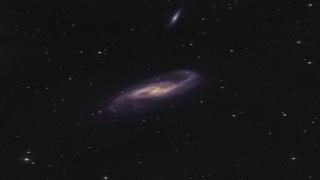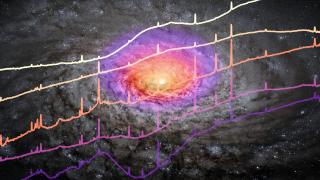Bibcode
Wisotzki, L.; Bacon, R.; Brinchmann, J.; Cantalupo, S.; Richter, P.; Schaye, J.; Schmidt, K. B.; Urrutia, T.; Weilbacher, P. M.; Akhlaghi, M.; Bouché, N.; Contini, T.; Guiderdoni, B.; Herenz, E. C.; Inami, H.; Kerutt, J.; Leclercq, F.; Marino, R. A.; Maseda, M.; Monreal-Ibero, A.; Nanayakkara, T.; Richard, J.; Saust, R.; Steinmetz, M.; Wendt, M.
Referencia bibliográfica
Nature, Volume 562, Issue 7726, p.229-232
Fecha de publicación:
10
2018
Revista
Número de citas
154
Número de citas referidas
135
Descripción
Galaxies are surrounded by large reservoirs of gas, mostly hydrogen,
that are fed by inflows from the intergalactic medium and by outflows
from galactic winds. Absorption-line measurements along the lines of
sight to bright and rare background quasars indicate that this
circumgalactic medium extends far beyond the starlight seen in galaxies,
but very little is known about its spatial distribution. The
Lyman-α transition of atomic hydrogen at a wavelength of 121.6
nanometres is an important tracer of warm (about 104 kelvin)
gas in and around galaxies, especially at cosmological redshifts greater
than about 1.6 at which the spectral line becomes observable from the
ground. Tracing cosmic hydrogen through its Lyman-α emission has
been a long-standing goal of observational astrophysics1-3,
but the extremely low surface brightness of the spatially extended
emission is a formidable obstacle. A new window into circumgalactic
environments was recently opened by the discovery of ubiquitous extended
Lyman-α emission from hydrogen around high-redshift
galaxies4,5. Such measurements were previously limited to
especially favourable systems6-8 or to the use of massive
statistical averaging9,10 because of the faintness of this
emission. Here we report observations of low-surface-brightness
Lyman-α emission surrounding faint galaxies at redshifts between 3
and 6. We find that the projected sky coverage approaches 100 per cent.
The corresponding rate of incidence (the mean number of Lyman-α
emitters penetrated by any arbitrary line of sight) is well above unity
and similar to the incidence rate of high-column-density absorbers
frequently detected in the spectra of distant quasars11-14.
This similarity suggests that most circumgalactic atomic hydrogen at
these redshifts has now been detected in emission.
Proyectos relacionados

Las Galaxias Espirales: Evolución y Consecuencias
Nuestro grupo pequeño esta bien conocido y respetado internacionalmente por nuestro trabajo inovativo e importante en varios aspectos de la estructura y la evolución de las galaxias espirales cercanas. Usamos principalmente observaciones en varias longitudes de onda, explotando las sinergías que nos permiten responder a las cuestiones más
Johan Hendrik
Knapen Koelstra

Actividad Nuclear en Galaxias: una Perspectiva 3D del Núcleo y su Entorno
Nuestro proyecto puede dividirse en dos líneas principales de investigación. En primer lugar, el estudio de los vientos producidos por cuásares luminosos oscurecidos y del impacto que estos tienen en sus galaxias anfitrionas (retroalimentación del AGN). Para ello hemos obtenido observaciones en el óptico e infrarrojo cercano con el Gran Telescopio
Cristina
Ramos Almeida